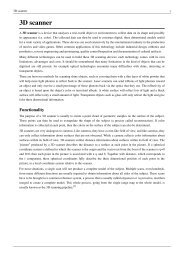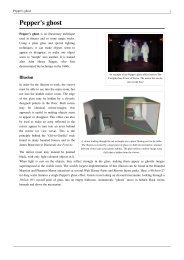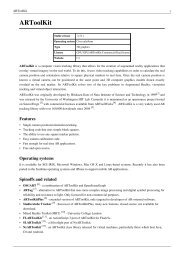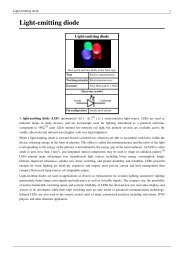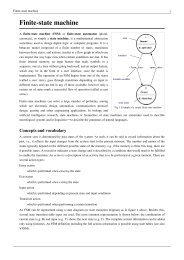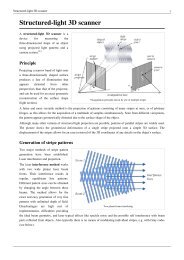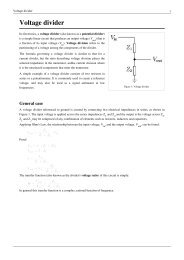LIDAR - Wikipedia, the free encyclopedia.pdf - Ex-ch.com
LIDAR - Wikipedia, the free encyclopedia.pdf - Ex-ch.com
LIDAR - Wikipedia, the free encyclopedia.pdf - Ex-ch.com
Create successful ePaper yourself
Turn your PDF publications into a flip-book with our unique Google optimized e-Paper software.
<strong>LIDAR</strong> 4<br />
of interest. The higher <strong>the</strong> concentration of <strong>the</strong> gas, <strong>the</strong> stronger <strong>the</strong> magnitude of <strong>the</strong> backscattered signal.<br />
Doppler <strong>LIDAR</strong> is used to measure wind speed along <strong>the</strong> beam by measuring <strong>the</strong> frequency shift of <strong>the</strong> backscattered<br />
light. Scanning <strong>LIDAR</strong>s, su<strong>ch</strong> as NASA's HARLIE <strong>LIDAR</strong>, have been used to measure atmospheric wind velocity<br />
in a large three dimensional cone. [5] ESA's wind mission ADM-Aeolus will be equipped with a Doppler <strong>LIDAR</strong><br />
system in order to provide global measurements of vertical wind profiles. [6] A doppler <strong>LIDAR</strong> system was used in<br />
<strong>the</strong> 2008 Summer Olympics to measure wind fields during <strong>the</strong> ya<strong>ch</strong>t <strong>com</strong>petition. [7] Doppler <strong>LIDAR</strong> systems are<br />
also now beginning to be successfully applied in <strong>the</strong> renewable energy sector to acquire wind speed, turbulence,<br />
wind veer and wind shear data. Both pulsed and continuous wave systems [8] are being used. Pulsed systems using<br />
signal timing to obtain vertical distance resolution, whereas continuous wave systems rely on detector focusing.<br />
Syn<strong>the</strong>tic Array <strong>LIDAR</strong> allows imaging <strong>LIDAR</strong> without <strong>the</strong> need for an array detector. It can be used for imaging<br />
Doppler velocimetry, ultra-fast frame rate (MHz) imaging, as well as for speckle reduction in coherent <strong>LIDAR</strong>. [9]<br />
Wind power<br />
Lidar is sometimes used on wind farms [10] to more accurately measure wind speeds and wind turbulence, and an<br />
experimental [11] lidar is mounted on a wind turbine rotor [12] to measure on<strong>com</strong>ing horizontal winds, and proactively<br />
adjust blades to protect <strong>com</strong>ponents and increase power.<br />
Geology and Soil Science<br />
High-resolution digital elevation maps generated by airborne and stationary <strong>LIDAR</strong> have led to significant advances<br />
in geomorphology, <strong>the</strong> bran<strong>ch</strong> of geoscience concerned with <strong>the</strong> origin and evolution of Earth's surface topography.<br />
<strong>LIDAR</strong>'s abilities to detect subtle topographic features su<strong>ch</strong> as river terraces and river <strong>ch</strong>annel banks, measure <strong>the</strong><br />
land surface elevation beneath <strong>the</strong> vegetation canopy, better resolve spatial derivatives of elevation, and detect<br />
elevation <strong>ch</strong>anges between repeat surveys have enabled many novel studies of <strong>the</strong> physical and <strong>ch</strong>emical processes<br />
that shape landscapes. In addition to <strong>LIDAR</strong> data collected by private <strong>com</strong>panies, academic consortia have been<br />
created to support <strong>the</strong> collection, processing and ar<strong>ch</strong>iving of resear<strong>ch</strong>-grade, publicly available <strong>LIDAR</strong> datasets. The<br />
National Center for Airborne Laser Mapping (NCALM) [13] , supported by <strong>the</strong> National Science Foundation, collects<br />
and distributes <strong>LIDAR</strong> data in support of scientific resear<strong>ch</strong> and education in a variety of fields, particularly<br />
geoscience and ecology.<br />
In geophysics and tectonics, a <strong>com</strong>bination of aircraft-based <strong>LIDAR</strong> and GPS have evolved into an important tool<br />
for detecting faults and measuring uplift. The output of <strong>the</strong> two te<strong>ch</strong>nologies can produce extremely accurate<br />
elevation models for terrain that can even measure ground elevation through trees. This <strong>com</strong>bination was used most<br />
famously to find <strong>the</strong> location of <strong>the</strong> Seattle Fault in Washington, USA. [14] This <strong>com</strong>bination is also being used to<br />
measure uplift at Mt. St. Helens by using data from before and after <strong>the</strong> 2004 uplift. [15] Airborne <strong>LIDAR</strong> systems<br />
monitor glaciers and have <strong>the</strong> ability to detect subtle amounts of growth or decline. A satellite based system is<br />
NASA's ICESat whi<strong>ch</strong> includes a <strong>LIDAR</strong> system for this purpose. NASA's Airborne Topographic Mapper [16] is also<br />
used extensively to monitor glaciers and perform coastal <strong>ch</strong>ange analysis. The <strong>com</strong>bination is also used by soil<br />
scientists while creating a soil survey. The detailed terrain modeling allows soil scientists to see slope <strong>ch</strong>anges and<br />
landform breaks whi<strong>ch</strong> indicate patterns in soil spatial relationships.








